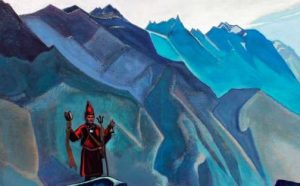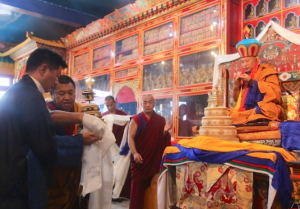The essence of Buddhist practice is not so much an effort at changing your thoughts or your behavior so that you can become a better person, but in realizing that no matter what you might think about the circumstances that define your life, you’re already good, whole, and complete. It’s about recognizing the inherent potential of your mind. In other words, Buddhism is not so much concerned with getting well as with recognizing that you are, right here, right now, as whole, as good, as essentially well as you could ever hope to be. — Yongey Mingyur Rinpoche

The revered meditation teacher and master of the Karma Kagyu and Nyingma lineages of Tibetan Buddhism Yongey Mingyur Rinpoche needs little introduction. His Dharmic legacy and community spans the globe and has made him one of the most prominent and widely recognized contemporary masters of the Tibetan Buddhist tradition. He is the founder of the Tergar Meditation Community, which has centers and practice groups in 30 countries, and is a best-selling author whose books include: The Joy of Living: Unlocking the Secret & Science of Happiness (2007); Joyful Wisdom: Embracing Change and Finding Freedom (2009); and Turning Confusion into Clarity: A Guide to the Foundation Practices of Tibetan Buddhism (2014).
Born in 1975 in the Himalayan border region between Tibet and Nepal, Mingyur Rinpoche received extensive training in Tibetan Buddhist meditative and philosophical traditions from his father, Tulku Urgyen Rinpoche (1920–96), considered one of the greatest modern Dzogchen masters, and continued his studies at Sherab Ling Monastery in northern India. After just two years of study and practice, at the age of 13, Mingyur Rinpoche entered a three-year meditation retreat and then completed a second immediately afterward, serving as retreat master. At 23, Rinpoche received full monastic ordination.
Rinpoche began teaching internationally in 1998, and by 2006 had established the first iteration of the Tergar Institute, offering teaching programs in Bodh Gaya. An aspiration to establish a cohesive community for students across the globe resulted in the formation of two organizations: Tergar International and Tergar Asia, which became the foundation of his vision for a global meditation community, which now supports a wide range of online and in-person programs and resources for Buddhist study and practice.
Mingyur Rinpoche famously undertook an extended period of solitary retreat through the Himalayan mountains from 2011–15. In recounting how he came to terms with the realities of his ambition to practice in the manner of a wandering yogi, Rinpoche revealed that he confronted many personal and spiritual challenges—including, at one point, his own mortality. Rinpoche has described the years he spent wandering in the Himalaya as “one of the best periods of my life.”*
During a brief respite from his busy teaching schedule, Rinpoche graciously sat down with BDG at Tergar Osel Ling, the heart of the Tergar lineage and community in Kathmandu, to share his wisdom and perspectives on practice for contemporary students of the Buddhadharma.

BDG: In your book In Love with the World, you describe your wandering retreat that began in 2011. Could you share how this experience transformed your understanding of impermanence and letting go?
Yongey Mingyur Rinpoche: During that wandering retreat, I had no particular plan for shelter. I carried only a little money, which ran out within a month! So I had no particular plan for money, just wandering freely. It was very difficult, and at the beginning I almost died. So now I usually recommend to others, maybe don’t do that style of retreat!
We all have unexpected problems in our lives, so there’s no need to go looking for more problems—problems will look for us! And that’s usually a great opportunity; problems can be a solution for our inner development because we can learn from our problems, we can grow from our obstacles.
But I learned two things from that experience. One was coming out from my cocoon; I learned a lot about life. Second, I learned a lot about the Dharma—awareness, loving compassion, and wisdom—especially when I almost died, I experienced directly that awareness never dies. Life is unborn, it is emptiness, so how can you die?
So because of this, the wandering retreat was one of the best periods in my life—although it was difficult.
BDG: You’ve been very open about your past struggles with anxiety. In your experience, what are the most common misconceptions about anxiety among Buddhist practitioners?
YMR: In Buddhism we have many different practices. Sometimes, we need to respect relative reality; sometimes we jump into the ultimate reality of emptiness and we think: “Panic is emptiness, so I don’t need to go to therapy, I don’t need to do physical exercise. I don’t have to receive treatment because panic is emptiness.” But maybe you have not yet achieved this level of understanding because, normally, to attain what we call the wisdom of emptiness, we need to go through three layers at the beginning: first we learn the conceptual level, but you don’t yet understand emptiness at the second level, the feeling level, and panic operates at the feeling level. So a conceptual understanding of emptiness doesn’t help!
Many Buddhists misunderstand: “Everything is emptiness, therefore feelings are emptiness, so why do I still have panic attacks?” Thus they sometimes feel disappointed. Then there’s the third layer, the imprint aspect. Here habitual patterns are even more difficult to change. I think that there’s a lot of misunderstanding around these concepts in the Buddhist community.
BDG: In our increasingly digital world, many people struggle with distraction and reduced attention spans. What guidance do you offer for maintaining mindful presence in this context?
YMR: Normally, in our tradition, what we call meditation should be creative and fresh. Although everything comes down to our awareness, there are so many techniques, which means that we can meditate anywhere, at any time, with any phenomena. After a certain level, it’s not unusual to become bored with simple breath meditation. So then we can try sound meditation, or sensation meditation, or even with panic attacks—what we call making friends with our panic attacks. Panic attacks can thereby become a support for our awareness; you can even get a kind of happiness from panic attacks!
So we can work creatively. We might say, “OK, this week, maybe I’m going to work with laziness for my meditation; maybe looking at samatha (Skt. serenity); maybe working with exercise for my meditation. So we’re incorporating creativity and change, yet although the object of our meditation changes, our awareness, that single-pointed samadhi (Skt: meditative consciousness), is always there.
BDG: Your teachings often emphasize the “joy” of practice. How do you help students to differentiate between temporary happiness and genuine, lasting joy?
YMR: Temporary happiness is something like winning the lottery. I’ve had a lot of discussions with scientists: 10 years ago they would say that this kind of happiness lasts for two years, but now they say it lasts for only a few months. In marriage, it’s good for five years, but now they say maybe a few months or a couple of years! Or, say you suddenly became famous or powerful, scientists say that even these cannot change our baseline of happiness.
What is this baseline? In Buddhism we talk about duhkha, a deep-level sense of unsatisfactoriness, a feeling of incompleteness. Even if you win the lottery, that happiness cannot fill this sense of hollowness. It remains, although you may look a little more happy. This is surface-level happiness, not real happiness. But when you connect with basic innate goodness—let’s say if you connect with loving compassion—you truly feel happy. If you help others, you really feel happy, you feel like you’re coming home, you feel like “this is me.” That hollowness will leave. If you connect with awareness, the“boring” practice of watching your breath, you can also sense that hollowness, but scientists say that this can also change that baseline of happiness. Winning the lottery cannot change your baseline happiness, but watching your “boring” breath can change your baseline. And the same goes for wisdom, of course.
So these three things represent real joy. And that joy is more like contentment: a feeling of completeness; a feeling of well-being. Fundamental “OK-ness.” This cannot be compared with “happiness” from a cup of coffee or winning the lottery.
BDG: As both an accomplished meditation master and a lifelong student of the Dharma, what still challenges you in your practice?
YMR: I do have some struggles. In particular: should I teach more, or should I focus on my own practice and retreat? This is a point of struggle for me because I like both! Of course, I try to find a balance. Sometimes I’ll undertake a personal retreat—in one year I might spend one or two months in solitary retreat—and the rest of the year I spend teaching. But that is one of my challenges.
BDG: Many young people are drawn to Buddhism but struggle with traditional forms of practice. How do you adapt these ancient teachings while maintaining their essence?
YMR: What I’ve come up with is a program we call “Joy of Living,” and before that there was what I call “Anywhere Anytime Meditation,” in which I try to maintain this essence. When the Buddha lived in India, there were not so many different schools, traditions, and rituals; people would focus on the essence of practice: awareness, loving compassion, and wisdom. When we go to the essence, any barriers that may come from rituals or culture, I think, no longer matter.
We also train a lot of meditation teachers—the first batch graduated last September—so now we have almost 200 new trainees. And through “Anywhere Anytime Meditation” and “Joy of Living,” through our programs, we teach about awareness, loving compassion, and wisdom. These are extremely relevant to modern life, I think, and easily accessible for young people.
They can be accessed online, you can study Joy of Living 1 from your home. You receive a short video, then you do homework, experiential practice, and when you’ve completed it you can move onto the next part.
BDG: How do you envision the future of Buddhism in the West? What adaptations might be necessary while preserving the authentic Buddhadharma?
YMR: I think it’s really important that we go to the essence of the Buddhadharma, those three aspects we have mentioned: awareness, loving compassion, and wisdom. That we must not lose. The culture can change, examples can change, but not how we apply the teachings according to your intellect, personality, and aspiration. The Buddha said: teach my Dharma according to three things: བློ (lo), ཁམས (kham), མོས་པ (möpa); lo meaning intellectual aptitude; kham meaning personality; and möpa meaning aspiration. We need to teach according to these factors. I think this is a very important way to adapt to the future without losing touch with the essential essence of the Buddhist teaching.
BDG: Is there anything else you’d like to share with our readers about the path of awakening in these challenging times?
YMR: Nowadays we see a lot of polarization, wars being waged, climate change, widespread anxiety, social discrimination . . . I think that we all share a kind of common ground which is what we can call basic goodness. Everyone shares the three innate qualities of awareness, loving compassion, and wisdom, but the problem is that we fail to recognize them. But if we try to connect with each other through the level of basic innate goodness, and try to see this awareness, loving compassion, and wisdom within yourself and within people around you, then we can find our common ground. Although we may all seem unique and we might all be different, it’s okay because our fundamental nature is the same. It’s very important to always remember that our common ground comes from awareness, loving compassion, and wisdom.
BDG: Thank you very much for sharing your time with us, Rinpoche.

Shortly before undertaking his wandering retreat in June 2011, Mingyur Rinpoche shared a message with his students and followers around the world about his intentions and aspirations. His message concluded with the following adjuration:
In parting, I would like to give you one small piece of advice to keep in your heart. You may have heard me say this before, but it is the key point of the entire path, so it bears repeating: All that we are looking for in life—all the happiness, contentment, and peace of mind—is right here in the present moment. Our very own awareness is itself fundamentally pure and good. The only problem is that we get so caught up in the ups and downs of life that we don’t take the time to pause and notice what we already have.
Don’t forget to make space in your life to recognize the richness of your basic nature, to see the purity of your being and let its innate qualities of love, compassion, and wisdom naturally emerge. Nurture this recognition as you would a small seedling. Allow it to grow and flourish.
* Yongey Mingyur Rinpoche Returns from Four-year Wilderness Retreat (BDG) and Yongey Mingyur Rinpoche Releases Video Offering Insights Following His Retreat (BDG)
References
Mingyur, Yongey. 2007. The Joy of Living: Unlocking the Secret and Science of Happiness. New York City: Harmony.
See more
Tergar International
Tergar Asia
Meditation for Daily Life (Tergar)
Related features from BDG
The Good News of Suffering: Four Questions on the Four Noble Truths with Yongey Mingyur Rinpoche
Living with Awareness, Practicing with Intent: An Interview with Yongey Mingyur Rinpoche
Exclusive Interview: Yongey Mingyur Rinpoche on Living Life with Balance and Awareness














